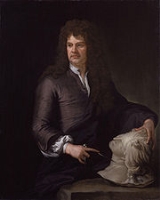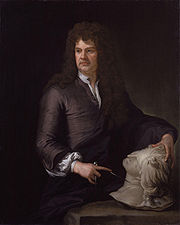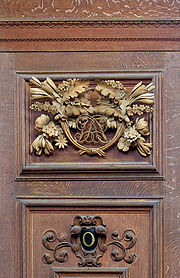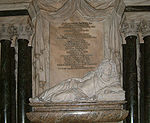
Grinling Gibbons
Encyclopedia

St Paul's Cathedral
St Paul's Cathedral, London, is a Church of England cathedral and seat of the Bishop of London. Its dedication to Paul the Apostle dates back to the original church on this site, founded in AD 604. St Paul's sits at the top of Ludgate Hill, the highest point in the City of London, and is the mother...
, Blenheim Palace
Blenheim Palace
Blenheim Palace is a monumental country house situated in Woodstock, Oxfordshire, England, residence of the dukes of Marlborough. It is the only non-royal non-episcopal country house in England to hold the title of palace. The palace, one of England's largest houses, was built between...
and Hampton Court Palace
Hampton Court Palace
Hampton Court Palace is a royal palace in the London Borough of Richmond upon Thames, Greater London; it has not been inhabited by the British royal family since the 18th century. The palace is located south west of Charing Cross and upstream of Central London on the River Thames...
. He was born and educated in Holland where his father was a merchant. He is widely regarded as the finest wood carver working in England, and the only one whose name is widely known among the general public. Most of his work is in wood, especially decorative Baroque
Baroque
The Baroque is a period and the style that used exaggerated motion and clear, easily interpreted detail to produce drama, tension, exuberance, and grandeur in sculpture, painting, literature, dance, and music...
garlands made up of still-life elements at about life size, made to frame mirrors and decorate the walls of churches and palaces, but he also produced furniture and small relief plaques with figurative scenes. He also worked in stone, mostly for churches. By the time he was established he led a large workshop, and the extent to which his personal hand appears in later work varies.
Life
Very little is known about his early life. The name Grinling is formed from sections of two family names.He was born in Rotterdam
Rotterdam
Rotterdam is the second-largest city in the Netherlands and one of the largest ports in the world. Starting as a dam on the Rotte river, Rotterdam has grown into a major international commercial centre...
, Netherlands, and it is sometimes thought that his father may have been the Englishman Samuel Gibbons, who worked under Inigo Jones
Inigo Jones
Inigo Jones is the first significant British architect of the modern period, and the first to bring Italianate Renaissance architecture to England...
, but even two of his closest acquaintances, the portrait painter Thomas Murray and the diarist John Evelyn
John Evelyn
John Evelyn was an English writer, gardener and diarist.Evelyn's diaries or Memoirs are largely contemporaneous with those of the other noted diarist of the time, Samuel Pepys, and cast considerable light on the art, culture and politics of the time John Evelyn (31 October 1620 – 27 February...
, cannot agree on how he came to be introduced to King Charles II
Charles II of England
Charles II was monarch of the three kingdoms of England, Scotland, and Ireland.Charles II's father, King Charles I, was executed at Whitehall on 30 January 1649, at the climax of the English Civil War...
. He moved to Deptford, England around 1667, and by 1693 had accepted commissions from the royal family and had been appointed as a master carver. By 1680 he was already known as the "King's Carver", and carried out exquisite work for St Paul's Cathedral, the Palace of Windsor, and the Earl of Essex's house at Cassiobury
Cassiobury House
Cassiobury House was a country house in Watford, Hertfordshire, England, now demolished.-History:The house was started in 1546 by Sir Richard Morrison. On the marriage of his granddaughter it passed into the ownership of the Capel family, later Earls of Essex. It was demolished in 1927. The...
. His carving was so fine that it was said a pot of carved flowers above his house in London would tremble from the motion of passing coaches. He was a Quaker.
The diarist Evelyn first discovered Gibbons' talent by chance in 1671. Evelyn, from whom Gibbons rented a cottage near Evelyn's home in Sayes Court
Sayes Court
Located in Deptford, in the London Borough of Lewisham and on the Thames Path, Sayes Court once attracted throngs to visit its celebrated garden created by the seventeenth century diarist John Evelyn...
, Deptford (today part of south-east London
London
London is the capital city of :England and the :United Kingdom, the largest metropolitan area in the United Kingdom, and the largest urban zone in the European Union by most measures. Located on the River Thames, London has been a major settlement for two millennia, its history going back to its...
), wrote the following: "I saw the young man at his carving, by the light of a candle. I saw him to be engaged on a carved representation of Tintoretto
Tintoretto
Tintoretto , real name Jacopo Comin, was a Venetian painter and a notable exponent of the Renaissance school. For his phenomenal energy in painting he was termed Il Furioso...
's "Crucifixion", which he had in a frame of his own making." Later that same evening, Evelyn described what he had seen to Sir Christopher Wren. Wren and Evelyn then introduced him to King Charles II who gave him his first commission - still resting in the dining room of Windsor Castle
Windsor Castle
Windsor Castle is a medieval castle and royal residence in Windsor in the English county of Berkshire, notable for its long association with the British royal family and its architecture. The original castle was built after the Norman invasion by William the Conqueror. Since the time of Henry I it...
.
Horace Walpole later wrote about Gibbons: "There is no instance of a man before Gibbons who gave wood the loose and airy lightness of flowers, and chained together the various productions of the elements with the free disorder natural to each species."
Gibbons is buried at St Paul's, Covent Garden
St Paul's, Covent Garden
St Paul's Church, also commonly known as the Actors' Church, is a church designed by Inigo Jones as part of a commission by Francis Russell, 4th Earl of Bedford in 1631 to create "houses and buildings fitt for the habitacons of Gentlemen and men of ability" in Covent Garden, London, England.As well...
, London. There are still direct descendants of Gibbons in the UK today who have followed the family tradition of wood carving down through 13 generations. One male produces fine English rocking horses and works to commissioned carvings and restorations. His carvings can be viewed in Ironbridge, Shropshire, UK.
Work


St Paul's Cathedral
St Paul's Cathedral, London, is a Church of England cathedral and seat of the Bishop of London. Its dedication to Paul the Apostle dates back to the original church on this site, founded in AD 604. St Paul's sits at the top of Ludgate Hill, the highest point in the City of London, and is the mother...
and later was appointed as master carver to George I. He was also commissioned by King William III to create carvings, some of which adorn Kensington Palace today. An example of his work can be seen in the Prescence Chamber above the fireplace, which was originally intended to frame a portrait of Queen Mary II after her death in 1694. Also in the Orangery at Kensington, you can see some examples of his work. Many fine examples of his work can still be seen in the churches around London - particularly the choir stalls and organ case of St Paul's Cathedral. Some of the finest examples of Gibbons work accessible to the general public are those on display at the National Trust's Petworth House
Petworth House
Petworth House in Petworth, West Sussex, England, is a late 17th-century mansion, rebuilt in 1688 by Charles Seymour, 6th Duke of Somerset, and altered in the 1870s by Anthony Salvin...
in West Sussex, UK. At Petworth the Carved Room is host to a fine and extensive display of intricate wooden carvings by Gibbons.
His association with Deptford is commemorated locally: Grinling Gibbons Primary School is in Clyde Street, near the site of Sayes Court, and St. Nicholas' Church has The Valley of the Dry Bones, one of Gibbons' works, permanently on display. His work can be seen in the London churches of St Michael Paternoster Royal and St James, Piccadilly, where he carved the wood reredos
Reredos
thumb|300px|right|An altar and reredos from [[St. Josaphat's Roman Catholic Church|St. Josaphat Catholic Church]] in [[Detroit]], [[Michigan]]. This would be called a [[retable]] in many other languages and countries....
and marble font. The Anglican dislike of painted altarpiece
Altarpiece
An altarpiece is a picture or relief representing a religious subject and suspended in a frame behind the altar of a church. The altarpiece is often made up of two or more separate panels created using a technique known as panel painting. It is then called a diptych, triptych or polyptych for two,...
s typically left a large space on the east wall that needed filling, which often gave Grinling's garlands a very prominent position, as here.
The famous sculptor of Brussels
Brussels
Brussels , officially the Brussels Region or Brussels-Capital Region , is the capital of Belgium and the de facto capital of the European Union...
Peter van Dievoet
Peter Van Dievoet
Peter van Dievoet was a Belgian sculptor and designer of ornamental architectural features. He was born in Brussels, baptised 29 June 1661 in the church of Sainte-Gudule, died 2 March 1729 in Brussels....
had collaborated with Grinling Gibbons, but went back to Brussels
Brussels
Brussels , officially the Brussels Region or Brussels-Capital Region , is the capital of Belgium and the de facto capital of the European Union...
after the revolution of 1688.
Gibbons also made the monument for Admiral Sir Cloudesley Shovell
Cloudesley Shovell
Admiral of the Fleet Sir Cloudesley Shovell , was an English naval officer. Rising through the ranks and fighting in many of the important battles of the late 17th and early 18th centuries, he became a popular British hero, whose celebrated career was brought to an end in a disastrous shipwreck in...
, a British naval hero killed in a disastrous shipwreck in 1707
Scilly naval disaster of 1707
Scilly naval disaster of 1707 is an umbrella term for the events of 22 October 1707 that led to the sinking of a British naval fleet off the Isles of Scilly. With four large ships and more than 1,400 sailors lost in stormy weather, it was one of the greatest maritime disasters in the history of...
. Shovell's large marble monument can be seen in the south choir aisle of Westminster Abbey
Westminster Abbey
The Collegiate Church of St Peter at Westminster, popularly known as Westminster Abbey, is a large, mainly Gothic church, in the City of Westminster, London, United Kingdom, located just to the west of the Palace of Westminster. It is the traditional place of coronation and burial site for English,...
.
Gibbons' work very often includes carvings of pea
Pea
A pea is most commonly the small spherical seed or the seed-pod of the pod fruit Pisum sativum. Each pod contains several peas. Peapods are botanically a fruit, since they contain seeds developed from the ovary of a flower. However, peas are considered to be a vegetable in cooking...
pods. A myth states that he would include a closed pod in his work, only carving it open once he had been paid. If the pea pod was left shut it supposedly showed that he had not been paid for the work. This is implausible because he would not have left his carvings (that would have taken months to complete) in situ had he not been paid.
His work (with the exception of religious carvings) also often includes a 5-petal flower like a periwinkle
Vinca
Vinca is a genus of six species in the family Apocynaceae, native to Europe, northwest Africa and southwest Asia. The English name periwinkle is shared with the related genus Catharanthus .-Description:Vinca plants are subshrubs or herbaceous, and have slender trailing stems 1–2 m long...
or a Tudor rose
Tudor rose
The Tudor Rose is the traditional floral heraldic emblem of England and takes its name and origins from the Tudor dynasty.-Origins:...
. It is the crest still used by his modern descendent today.

